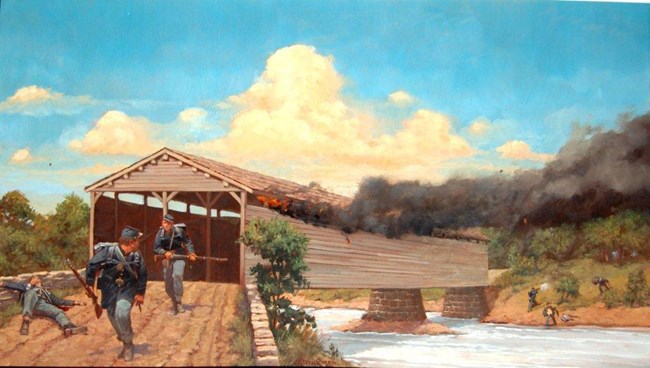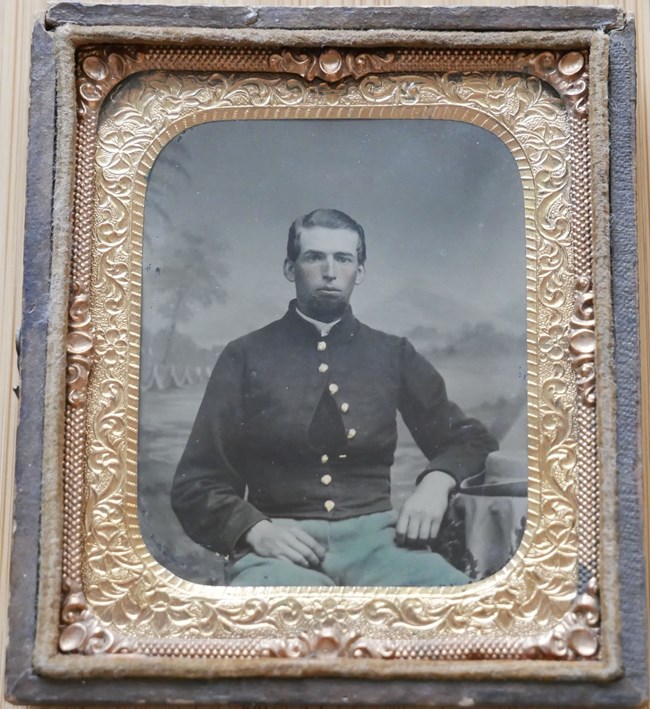
Alfred was just shy of his seventeen birthday when he enlisted in Company B, Ninth New York Heavy Artillery in Walworth on December 19, 1863. He was paid an enlistment bounty of $180. After mustering in at Auburn, New York, on December 29, 1863, Alfred was transported by boat down Seneca Lake to Elmira and then traveled by rail to join his regiment in the defenses of Washington, DC. Private Sova would spend the first few months of 1864 at Fort Mahan and Fort Foote. In early May, 1864, Lieut. General Ulysses S. Grant began the Overland Campaign against General Robert E. Lee’s Army of Northern Virginia. After sustaining heavy losses during the first battles of the campaign, Grant ordered many of the regiments defending Washington, DC, including the 9th New York Heavies, to the front lines near Richmond, Virginia. They were assigned to the Third Division, Sixth Corps and on June 1st, fighting as infantry, they entered their first battle at Cold Harbor. Soon the two armies settled in for, what would become, a nine-month siege around Petersburg, Virginia. During operations, the Third Division of the Sixth Corps was abruptly ordered to prepare to move out for Baltimore, MD. On July 6th, they boarded steamships at City Point, Virginia and were transported north to Baltimore and then traveled by railcar to Monocacy Junction, south of Frederick, Maryland. On July 9th, under the command of Major General Lew Wallace, they faced a much larger Confederate force under Lieut. General Jubal A. Early. The 9th New York, commanded by Colonel William H. Seward, Jr., was positioned on the west bank of the Monocacy River near a wooden, covered bridge. During the Battle of Monocacy, Alfred, along with Private Samuel Mack and Sergeant Albert Smith, was ordered to gather sheaves of wheat from a nearby field to place in the roof structure of the wooden bridge in anticipation of firing it to render it useless to the advancing Confederates. Sometime, between 11:00 a.m. and 2:00 p.m., General Wallace ordered the bridge burned. Alfred sprang out of the line of battle, climbed up a beam of the bridge, and lit the wheat sheaves on fire. The bridge was engulfed in flames; soon a huge column of smoke billowed across the battlefield. The burning bridge timbers crashed, into the river below and the Confederates were without easy passage towards Washington, DC. 
F.L. Rohrer Although the Battle of Monocacy was a Confederate victory, the gallant stand made by Union soldiers along the banks of the Monocacy River delayed Early’s advance on the National Capital and would come to be known as “The Battle that Saved Washington”. Following the retreat toward Baltimore, Maryland, the 9th New York Heavies rejoined the Sixth Corps and, as part of Major General Philip H. Sheridan’s Army of the Shenandoah, entered the Shenandoah Valley intent on pushing the Confederates south while consuming or destroying anything of military value. During this time, Alfred fell ill and was confined to Carver Hospital in Washington, DC for about six weeks. He rejoined his regiment near Winchester, Virginia by mid-October and saw action at the Battle of Cedar Creek on October 19, 1864. The Sixth Corps eventually rejoined Grant’s army in the siege lines around Petersburg, Virginia in December of 1864 and participated in the closing battles of the Civil War. Alfred was mustered out of the army in Washington, DC on June 16, 1865, and returned to Wayne County, New York. A few years later, he started a family and eventually moved to Jackson County, Michigan, where he lived in Leoni and Grass Lake for the remainder of his life. He was a dairy farmer and an active member of the Grand Army of the Republic. By the early 1930s, Alfred was recognized as the last surviving Civil War veteran in his community. Alfred N. Sova died on August 25, 1935 and was interred with full military honors in Maple Grove Cemetery located in Grass Lake, Michigan. Submitted on 24 February 2017 by F. L. Rohrer, great-grandson of Alfred N. Sova. |
Last updated: May 28, 2020
